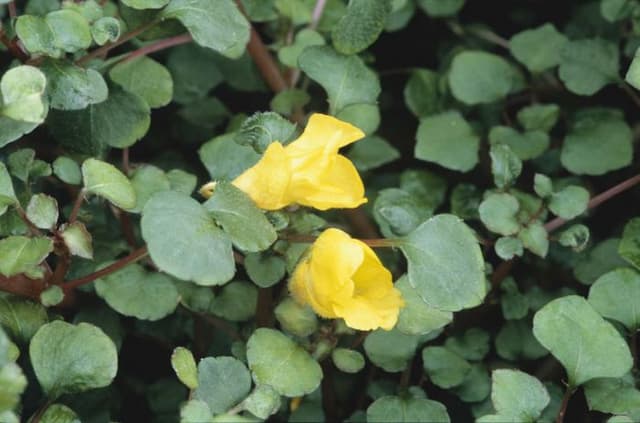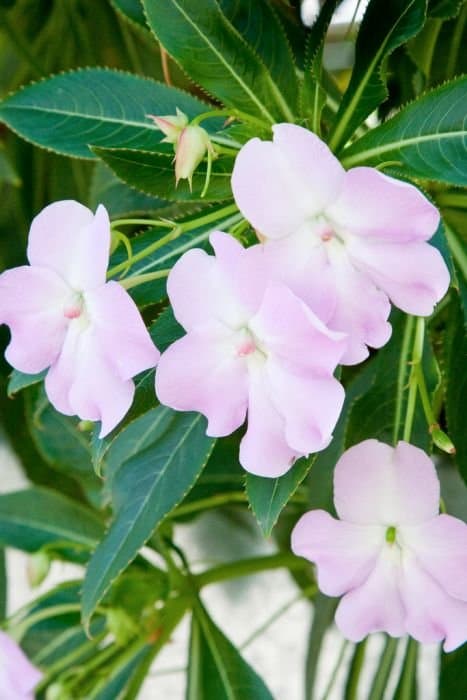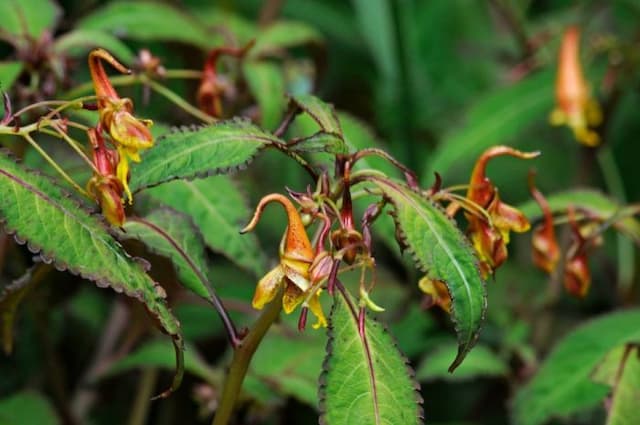Impatiens Impatiens Sun Harmony Deep Orange = 'Dhar328' (PBR) (Sun Harmony Series) (NG)
![busy lizzie [Sun Harmony Deep Orange]](/_next/image?url=https%3A%2F%2Fplants-admin.emdemapps.com%2Fimages%2Fplants%2F%2Fimages%2F604b57b5f28cb.png&w=3840&q=75)
ABOUT
Impatiens Sun Harmony Deep Orange, which belongs to the Sun Harmony Series, sports vibrant deep orange blossoms that create a showy display. These bright flowers are attractively contrasted against lush green foliage. The leaves are glossy and create a perfect backdrop for the vivid flowers that bloom prolifically. The flowers themselves are characterized by their round, plump appearance with overlapping petals that form a nearly spherical shape. The blooms are of a generous size and stand out against the verdant leaves, often described as jewel-toned for their rich, saturated color. This particular variety is well-suited for adding pops of color to garden spaces, giving a warm and lively vibe with its fiery orange hue. The plant has a robust and bushy growth habit, presenting a dense and full appearance that is both hearty and aesthetically pleasing.
About this plant
 Names
NamesFamily
Balsaminaceae.
Synonyms
Impatiens, Busy Lizzie, Balsam, Touch-me-not, Patient Lucy.
Common names
Impatiens hawkeri 'Dhar328'
 Characteristics
CharacteristicsLife cycle
Annuals
Foliage type
Evergreen
Color of leaves
Green
Flower color
Deep Orange
Height
10-16 inches (25-40 cm)
Spread
14-20 inches (35-50 cm)
Plant type
Herb
Hardiness zones
10
Native area
East Africa
Benefits
 General Benefits
General Benefits- Vibrant Color: Produces deep orange flowers that add bright and vivid color to gardens or containers.
- Sun Tolerance: Unlike other Impatiens, it can thrive in both sun and shade, making it versatile for different garden locations.
- Continuous Blooming: Flowers prolifically throughout the growing season without the need for deadheading.
- Disease Resistance: Bred for improved resistance to common Impatiens diseases such as downy mildew.
- Maintenance: Low maintenance requirements, making it suitable for novice gardeners or those with limited gardening time.
- Growth Habit: Compact and uniform growth ensures a tidy appearance without the need for pruning.
- Drought Tolerance: Exhibits a degree of drought tolerance once established, reducing the need for frequent watering.
- Attracts Pollinators: The flowers can attract butterflies and other pollinators to the garden, promoting biodiversity.
- Adaptable: Suitable for planting in garden beds, borders, containers or hanging baskets, providing flexibility in landscape design.
 Medical Properties
Medical PropertiesThis plant is not used for medical purposes.
 Air-purifying Qualities
Air-purifying QualitiesThis plant is not specifically known for air purifying qualities.
 Other Uses
Other Uses- Impatiens Sun Harmony Deep Orange can be used as a natural dye for textiles, giving a soft orange hue to fabrics.
- The petals of this Impatiens can be pressed and included in homemade paper for decorative effects.
- When dried, the flowers can be used to create colorful potpourri mixes, adding aesthetics and a mild fragrance to a room.
- The plant can be used in educational settings to teach about pollination and the needs of sun-loving varieties compared to traditional shade-loving Impatiens.
- As an artistic subject, its vibrant orange color is ideal for photography projects or painting botanical art.
- The sturdy stems of mature plants can be used as natural support for climbing plants when placed closely in a mixed container.
- Clusters of this Impatiens can be floated in water bowls as a natural table centerpiece for outdoor events.
- These flowers can be used in a sensory garden, as they have a distinct soft texture that can be explored by touch.
- In a butterfly or bee garden, Impatiens Sun Harmony Deep Orange can serve as an attractive source of nectar for pollinators.
- When crafting with children, the flowers can be used to create natural stamps for paper decorations.
Interesting Facts
 Feng Shui
Feng ShuiThe Impatiens is not used in Feng Shui practice.
 Zodiac Sign Compitability
Zodiac Sign CompitabilityThe Impatiens is not used in astrology practice.
 Plant Symbolism
Plant Symbolism- Patience: The common name "impatiens" relates to the Latin word for "impatient," referring ironically to the plant’s seed pods that burst open when ripe. However, in the symbolic context, it represents patience and enduring time with grace.
- Resilience: Impatiens show great resilience as they can bloom in both sunny and shaded areas, symbolizing adaptability and the ability to overcome challenges.
- Motherly Love: Often used in gardens or as a gift, these flowers can signify caring and a nurturing nature, akin to a mother's love for her children.
- Affection: The brightly colored flowers of Impatiens can also represent deep affection and friendship, often given to friends to show care and consideration.
 Water
WaterNew Guinea Impatiens should be watered regularly to maintain evenly moist soil, especially in the heat of summer. Water deeply to saturate the root zone at least once a week, although you may need to water more frequently during prolonged dry spells or when temperatures are particularly high. Avoid shallow watering, which can lead to weaker root growth. On average, this might translate to about 1 gallon of water per plant each week, but this can vary based on climate and soil conditions. Ensure proper drainage to prevent waterlogging, which can cause rot.
 Light
LightNew Guinea Impatiens thrive in bright, indirect light or dappled sunlight. They are tolerant of some direct sunlight but perform best when shielded from the intense midday sun, which can scorch their leaves. A spot that receives morning sun followed by afternoon shade or filtered light throughout the day is ideal.
 Temperature
TemperatureNew Guinea Impatiens prefer temperatures between 70 and 85 degrees Fahrenheit but can tolerate a range from about 60 to 90 degrees Fahrenheit. They may not survive temperatures that drop significantly below 60 degrees Fahrenheit for prolonged periods. The ideal temperature range for robust growth and flowering is on the warmer side of their tolerance.
 Pruning
PruningPruning New Guinea Impatiens is beneficial to encourage bushier growth and more blooms. Pinch back the stem tips every few weeks to promote branching, focusing on leggy or overgrown stems. The best time for pruning is in late spring or early summer as the plant starts to take off in growth, and thereafter, as needed to maintain shape and vigor.
 Cleaning
CleaningAs needed
 Soil
SoilNew Guinea Impatiens thrive in well-draining, rich organic soil with a pH of 6.0 to 6.5. For best growth, mix peat moss, potting soil, and perlite in equal parts to ensure moisture retention and good drainage.
 Repotting
RepottingNew Guinea Impatiens should typically be repotted every 1-2 years during spring. Choose a container slightly larger than the previous one to give roots room to grow.
 Humidity & Misting
Humidity & MistingNew Guinea Impatiens prefer high humidity levels, around 50-70%. They flourish when the air is moist but not too wet, which helps their foliage stay healthy.
 Suitable locations
Suitable locationsIndoor
Place in bright, indirect light and keep soil moist.
Outdoor
Choose partial sun location, protect from strong wind.
Hardiness zone
10-12 USDA
 Life cycle
Life cycleNew Guinea Impatiens 'Sun Harmony Deep Orange' begins its life cycle as a seed that germinates in warm, moist soil, typically in late winter or early spring in greenhouse conditions. After germination, the seedling develops true leaves and grows rapidly, transitioning into the vegetative stage where it focuses on leaf and stem growth. As the plant matures, it enters the flowering stage, usually in late spring or early summer, producing vibrant deep orange blooms that attract pollinators and can self-fertilize to produce seeds. Throughout the summer and into fall, the plant continues to flower profusely as long as it is provided with enough light and kept from extreme heat. As temperatures cool and daylight shortens, the plant transitions into senescence, where growth slows, and flowers drop off, signaling the end of its annual lifecycle, as New Guinea Impatiens are generally treated as annuals outside of their native tropical climate. However, some gardeners may overwinter the plants indoors or propagate cuttings to preserve the plant for the following season.
 Propogation
PropogationPropogation time
Spring-Early Summer
The Impatiens Sun Harmony Deep Orange is typically propagated using seed or cuttings, with cuttings being the more popular method due to the plant's patent protection, which can restrict the use of seeds for propagation without permission. To propagate from cuttings, a healthy, non-flowering stem approximately 4 to 6 inches (about 10 to 15 cm) long is taken with a sharp, clean tool. This cutting should have at least two sets of leaves. The bottom set of leaves is removed, and the cut end is dipped in rooting hormone before being placed in a well-draining potting mix. The container is then kept moist but not waterlogged, in bright, indirect sunlight at a warm temperature until roots develop, which can take several weeks. Once the cutting has established a strong root system, it can be transplanted to its final location.
![Busy lizzie [SunPatiens Compact Blush Pink]](/_next/image?url=https%3A%2F%2Fplants-admin.emdemapps.com%2Fimages%2Fplants%2F%2Fimages%2F604b64a6f0b6f.png&w=640&q=75)
![Busy lizzie [Divine Violet]](/_next/image?url=https%3A%2F%2Fplants-admin.emdemapps.com%2Fimages%2Fplants%2F%2Fimages%2F604b651b90e59.png&w=640&q=75)




![Busy lizzie [SunPatiens Compact Orange]](/_next/image?url=https%3A%2F%2Fplants-admin.emdemapps.com%2Fimages%2Fplants%2F%2Fimages%2F604b5ef883e70.png&w=640&q=75)
![Busy lizzie [SunPatiens Vigorous Magenta]](/_next/image?url=https%3A%2F%2Fplants-admin.emdemapps.com%2Fimages%2Fplants%2F%2Fimages%2F604b622adf631.png&w=640&q=75)

